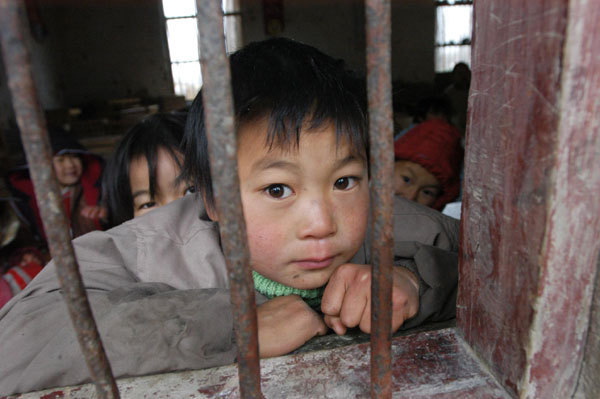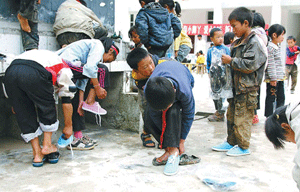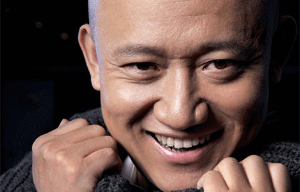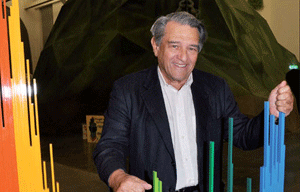Progress made in HIV/AIDS campaign
Updated: 2011-11-25 06:50
By Shan Juan (China Daily)
|
|||||||||
 |
|
Nearly 75 percent of the 216 children who attend primary school in Lulou village, Anhui province, are HIV-positive or were orphaned when their parents died of AIDS. Many Anhui villagers were infected when they sold their blood illegally in the late 1980s and early 1990s. Wu Fang / for China Daily |
Latest official estimate shows slower rate of increase on the mainland, Shan Juan reports in Beijing.
About 780,000 people will be living with HIV/AIDS on the mainland by the end of this year, 40,000 more than 2009, according to an estimate issued jointly by the Ministry of Health and UNAIDS.
Nearly 370,000 sufferers have been detected, including 154,000 with full-blown AIDS, the report said. Of the 200,000 who need treatment according to World Health Organization (WHO) standards, 130,000 are receiving it.
The estimated number of new infections this year stands at 48,000. Nearly 82 percent of infections resulted from sex, including more than 29 percent through homosexual acts.
"The epidemic is still on the rise in China . . . but at a slower rate than previous years," Wu Zunyou, director of the National Center for AIDS and Sexually Transmitted Diseases Control and Prevention, said on Wednesday in an exclusive interview.
Wu said China had a low prevalence, meaning infection rates as a percentage of the population.
China's rate overall is 0.06 percent. The WHO defines high prevalence as 1 percent or more.
However, "sexual transmission is increasing, particularly among men having sex with men, and the virus is spreading into more diversified groups like the elderly and young students, which makes intervention more complex and tougher," Wu said.
Of the cases reported so far this year, roughly 20 percent were in people 50 and older, up 10 percentage points from 2007, statistics from the ministry showed.
"Most of them got infected through unprotected sex, because with improving health and their economic situation, some kept sexually active and sought prostitution," Wu said.
Infections among students ages 20 to 24 also increased, with 56 percent contracting the virus via gay sex.
Health coverage at 70%
"AIDS deaths on the mainland appear to be peaking, as a majority of the sufferers infected by contaminated blood during the botched blood- and plasma-selling schemes in the 1990s became full-blown patients," said Chen Zhongdan, UNAIDS national program officer.
By the end of October, 14,000 AIDS deaths were reported this year. The figure compares with 6,596 in all of 2009, official statistics showed.
Many rural people in Henan, Shanxi and Hubei provinces were infected via contaminated blood in the '90s, but the exact number has not been released officially.
To prevent or delay more deaths, Chen urged government to further expand the coverage of treatment. On average, he said, 70 percent of detected patients who need treatment are getting it.
"Coverage could reach 80 percent among those infected in the 1990s by contaminated blood," Chen said, but it is only about 30 percent for people who were drug users or men who had sex with men.
Impact of discrimination
Detection rates for those two groups are low because of discrimination and "limited medical capacity, particularly at the grassroots level". Interventions among those groups and sex workers have to be enhanced, Chen said.
According to a 2009 survey conducted by UNAIDS and China Central Party School, nearly 42 percent of the 2,000-plus respondents living with HIV/AIDS reported having faced some type of HIV-related discrimination.
In addition, 26 percent said they were not satisfied with the privacy protection at HIV screening outlets run largely by the semi-governmental Chinese Center for Disease Control and Prevention.
Xiao Dong, who heads a civic organization in Beijing
|
|
working to curb the spread of HIV among men who have gay sex, said many were reluctant to go for testing for fear their status would be exposed. "That may cost them timely treatment or even the chance of surviving the disease," he said.
China introduced free HIV/AIDS counseling and testing services and free medication for AIDS patients in the early 2000s, and those actions are credited with helping lower the mortality rate.
Meng Lin, an AIDS patient in Beijing, said he'll never forget his desperation when learning in 1995 that he was HIV-positive. "I just wanted to die while being told that the disease couldn't be treated at all."
Wang Kerong, a nurse who works with AIDS patients at Beijing Ditan Hospital, said some committed suicide in the early years when they learned their status.
In 1996, AIDS researcher David Ho pioneered a combination of antiretroviral drugs, widely known as cocktail therapy, that could control HIV replication in patients and largely prolong their lives. The AIDS death rate now is one-sixth what it was before the cocktail therapy.
Meng was invited that year to participate in a treatment trial at Beijing You'an Hospital and he felt that he might survive.
"The situation today is much better, with an established intervention mechanism including free testing and medication," he said. But he is concerned about side effects from the drugs, and he urged the government to keep improving the therapy as "medication could lower the viral load in patients, and thus better curb secondary infections."
China will further expand testing and intervention efforts, including education and drug coverage, said the country's 12th Five-Year Plan (2011-15) for HIV/AIDS prevention and control.
UNAIDS' Chen said the anti-AIDS campaign in China should be demand-driven more than supply-driven. "The government has invested so much and established a great network delivering services, so the key now is to attract more people to use the resources."
To achieve that, Chen said, civil societies must be involved in the anti-AIDS campaign led by the government. Wu agreed, citing his own experience.
In 1996, Wu designed and implemented the country's first pilot intervention program targeting sex workers at entertainment venues. The workers strongly rejected Wu and his colleagues at first.
One time, he said, they spent two hours at an entertainment parlor trying to talk to the workers about prevention, but no one listened. "That only changed after we ate together with them and even drank water from their cups."
More effective outreach
Thomas Cai, who heads AIDS Care China, a Guangzhou NGO that supports patients and their families, said civil societies could help the government better reach out to patients and people at high risk of HIV/AIDS.
Statistics from UNAIDS said China has hundreds of such organizations now but most are not registered with civil affairs authorities because policy requires that they affiliate with government units, which often don't want the responsibility. Also, most of them work with money from abroad, and have been called "Chinese children fed with foreign milk".
"That situation will be changed and the government will support such organizations on its own," Minister of Health Chen Zhu vowed in June. He made the comment after Global Fund, a Geneva-based international organization that supports disease prevention and control work worldwide, suspended grant money to China, citing poor government support for NGOs and suspected abuse of grants.
To some degree, Chen said then, "The process in China to fight AIDS has also brought in seeds for reforming social management."
Sun Weilin, who heads the Civil Affairs Ministry's social organization registration bureau, said the ministry was revising the law to make it easier for civil societies to register. The revision had been promised to be ready a month ago.
In the latest development, civil affairs authorities in Guangdong province said they would further streamline the registration process in July.
Social organizations there would be able to register at the local department of civil affairs without prior review and approval by the administrative departments in charge of the relevant fields.











